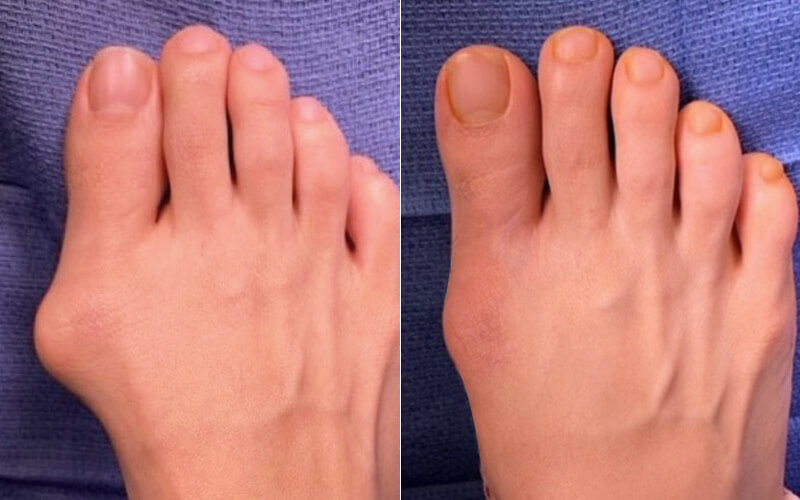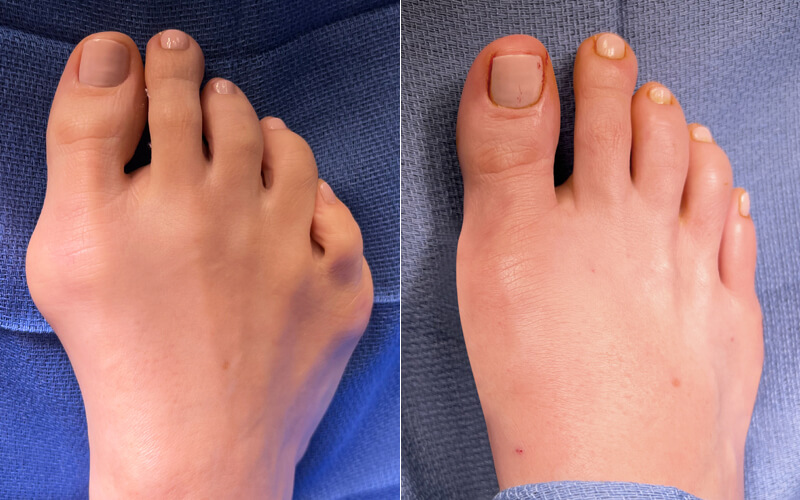Revision Bunion Surgery
- Under-correction
- Over-correction
- Bunion Recurrence
- Deformities
- Foot Pain
- Other Problems
The sooner that the corrective surgery is performed, the better the chances are for a successful repair. Discover why patients trust revision bunion surgery by Dr. Jamfeet to correct those painful or unsightly mistakes after a failed surgery.


About Revision Bunion Surgery:
A botched bunionectomy typically is intolerable to the patient, causing inability to walk without pain, continuous inability to bend the big toe joint, or even inability to fit into shoes. Other cases of failed bunion surgery involve over correction of the original deformity. thus causing what is called a Hallux Varus deformity. This deformity causes the big toe to deviate from being straight to dislocating the opposite direction from the second toe. This is a very unfortunate, preventable complication and in most cases must be repaired as soon as it is diagnosed. The patient may feel very frustrated and even ashamed to show their feet due to the very pronounced botched appearance of the big toe. Dr Jamshidinia’s expertise as a revision bunion surgeon allows patients to obtain the results that they had originally hoped for. With meticulous preoperative angular measurements of the patients x-rays, Dr Jamshidinia is able to design a very precise surgical plan to repair the big toe joint and create perfect balance of the supporting structures of the 1st MTPJ.
Revision bunion surgery is complex and a more complicated procedure than primary bunion surgery. This is because cartilage from the 1st metatarsal phalangeal joint can quickly erode due to bad post operative malalignment of the big toe joint from the previous surgery. Other issues that we have noted are painful unsightly scars and sometimes tightened skin causing lack of motion of the big toe joint. Dr Jamshidinia has been in practice for over 15 years and has performed for 10,000 procedures. He is sought after for not only primary bunion surgery but also revision bunionectomy for patients who have had post-operative complications, post-operative foot injuries, poor-post operative results and malalignments.
Trusted Revision Bunion Surgeon for Failed Bunion Repair
Bunion surgery can of course be botched or fail due to various reasons, including patient’s post operative non compliance with strict instructions, failure to utilize the Cam walker boot, negligence regarding post operative care, and post operative foot injuries. However, more common reasons are poor preoperative decisions, improper surgical execution by the surgeon, failure to address all aspects of the boney bunion deformity, and failure to address the Proximal Articular Set Angle or PASA. The choice of accurate technique and procedure by the surgeon is the most important determinant of surgical success.
Patients put a great deal of confidence onto their surgeons and trust them with their bodies. In such cases, a failed surgery turns out to be a big disappointment. Surgical complications and poor results directly impact the patient’s life forever until it is addressed properly before permanent cartilaginous damage ensues.
Therefore, it is essential to choose your surgeon wisely.
If you or someone you know has experienced a failed bunionectomy or botched bunion surgery due to any of these reasons, you should not worry as there are safe effective options available for most post-operative complications. It’s a good idea for you to get a revision bunion surgery done if you are having pain, difficulty walking, inability to wear shoes, or inability to bend the big toe joint. Furthermore, the sooner corrective surgery is performed the better the chances of repairing the abnormality.
Dr Jamshidinia is a board certified foot surgeon and renowned Bunion Specialist who has developed numerous innovative solutions for revision bunionectomy. As one of the most sought after foot surgeons in the nation, patients from all over the world have traveled to his center for corrective outpatient bunion surgery with hidden incision. He has also become very well-known for accepting cases where the results of a prior Bunionectomy were subpar and required revision surgery. Dr. Jamshidinia specializes in outpatient foot surgery, reconstructive forefoot and midfoot surgery, diabetic reconstructive foot surgery, and foot and ankle sports medicine. He is one of the most highly sought after Achilles tendon surgeons in California. Board Certified by American Board of Foot and Ankle Surgery, Dr. Jamshidinia has performed more than ten thousand procedures.
A Bunionectomy failure can leave the patient with deformity, dysfunction, and most importantly severe pain and patient dissatisfaction with the surgeon. It’s important to consider what the causes of surgical failure are. For most patients who have developed bunion deformity after corrective bunion surgery, the usual culprit is failure to address the Proximal Articular Set Angle by the surgeon. In other cases of complications a careless approach towards post-operative compliance can easily become a cause. However, bunion surgery fails are mostly due to improperly choosing the wrong surgical technique for the patient’s deformity. It should be noted that there are over 50 different bunion surgical techniques described in the literature and careful patient selection is essential to achieving great surgical outcomes.
If you are a patient who is unhappy with the results of your last foot surgery with another surgeon & want to learn more about revision foot surgery, call our office today to schedule a phone consultation or travel to our office in-person for an obligation-free, in-depth, evaluation including x-rays to ascertain the root cause of the undesirable outcome.
Reasons for Bunionectomy Failure & Botched Bunion Surgery:
Overcorrection or Hallux Varus
This failure involves excessive surgical resection and/or excessive correction of the Proximal Articular Set Angle and/or excessive reduction of the Intermetatarsal angle and poor surgical decision-making. Overcorrection of Bunions results in unfortunate sequel termed Hallux Varus which causes the big toe to drift excessively towards the other foot. The big toe then becomes misshapen and sometimes referred by patients that the big toe appears to be hitch hiking. This unfortunate outcome is due to a technical error of aggressive lateral soft-tissue release and unnecessary excessive resection of the metatarsal head and over correction of the intermetatarsal angle. It may cause pain and difficulty in mobility. Hallus Varus is a deformity condition of first metatarsal phalangeal joint. This condition is an avoidable complication, which may be treated by MTP arthrodesis technique, a reverse Austin technique or a Keller with implant technique. In case of post operative stiffness of the big toe joint, also called Hallux rigidus, there are several well known remedies that can be easily performed on an outpatient basis. Most revision bunion surgeries can be repaired in the outpatient setting and patients can go home the same day and are ambulatory in a special cam walker boot.
Incomplete Correction
Preoperative selection of appropriate procedure is essential for ensuring minimal chances of under-correction since every patent’s deformity is different. A bunion recurrence can take place due to such under-correction surgical error. Usually, a precise interpretation of the radiographic parameters by the surgeon for each patient’s deformity is important to avoid under-correction. If preoperative planning is not done and the patient is not fully evaluated errors in judgment can certainly occur in which the wrong procedure type is inappropriately selected for the patient. Inappropriate surgical procedure selection coupled with failure to address all of the patients deformity can lead to under correction or persistent deformity despite surgery. Not only will the surgery not fully correct the deformity, but also lack of full correction can cause the patient to experience the deformity again
Nonunion or Malunion
Nonunion and malunion after bunion surgery can certainly develop in case of small sized bones and relatively limited fixation area. The cause may be related to boney osteopenia condition or non-compliance of the patient after surgery and premature ambulation against medical advice. The technical errors during the procedure and failure to resect enough bone or failure to oppose the boney surfaces together with rigid fixation can certainly lead to mal union and non union. Dr. Jamshidinia, being a specialist in revision fixation carefully examines medical history of the patients, their record, results of previous surgery, and provides individual post operative care guidelines to eliminate the chances that a patient may create harm to themselves by not following post operative guidelines.
Medical Evaluation

Some procedures that Dr. Jamshidinia may use for your revision bunion surgery are as follows:
Tendons and Ligament Repair/ Soft Tissue Rebalancing after Failed Bunionectomy
Due to strain imbalance of toe tissues on each side, a deformity can form around the big toe. Dr. Jamshidinia uses a safe surgical procedure to truncate loose tissue and extend the shorter side. The minimally invasive procedure doesn’t require bone alignment and fixes the problem. This is a simple soft tissue correction for post operative alignment problems after failed bunionectomy.
Reverse Austin or other Osteotomy
After careful examination of the patient, Dr. Jamshidinia uses this procedure for joint alignment repair that can not be performed with just soft tissue repair of the tendons and ligaments. Supporting material is carefully used to realign the cut of the bone, making them balanced and straight. Partial removal of the bone technique is also used to ensure best medical and cosmetic results. The focus remains on using this technique in combination with tissue repair to realign the big toe joint and allow for full unrestricted big toe joint motion.
Arthrodesis or Big Toe Joint Fusion after failed Bunionectomy
For some patients, Dr. Jamshidinia may need to go with this option, in which the arthritic joint is removed and the joint is fused with surgical hardware. This procedure is used to address arthritic big toe joints that are not salvageable after primary bunionectomy.
Exostectomy or Cheilectomy after Failed Bunion Surgery
A bump on the toe joint is removed through this surgical procedure. This minimally invasive technique is used in combination with soft tissue repairs to ensure restoration of the alignment of the joint along with restoration of motion to the big toe joint. This procedure is aimed at alleviating the patient’s pain and allowing the big toe to bend. To ensure that deformity doesn’t recur, Dr. Jamshidinia may also consider using this procedure in combination with osteotomy.
Resection Arthroplasty after Failed Bunion Surgery with Post Operative OsteoArthritis
The damaged area of the joint is removed by the surgeon and the patient’s joint is covered by cadevaric tissue from the tissue bank and/or the patients own tissue is rearraged to prevent bones of the big toe joint from rubbing against one another. Dr Jam uses this technique frequently for endstage big toe joint arthritis in patients who can not tolerate a total joint replacement or fusion and require motion to the great toe joint. Many times this repair can be augmented with a total joint implant to the great toe joint.
Conclusion
Patients who are unhappy with the outcome of their bunion surgery with another surgeon, and want to learn more about revision bunion surgery can easily call our office to schedule a phone consultation or travel to our office for an in-depth, in person evaluation including x-rays to ascertain the root cause of the undesirable outcome. Most post operative short comings can be addressed thus it is important to seek surgical care anytime there is difficulty wearing shoes after surgery, difficulty bending the toe after foot surgery, recurrence of the bunion deformity despite foot surgery or chronic pain after foot surgery. These issues can easily be diagnosed with imaging coupled to measurements of boney angles on radiographic film and a thorough foot examination. Please call (310) 247-9255 if you have had undesirable outcome after foot surgery. Our office is looking forward to caring for you. Jamfeet is the trusted provider of premier bunion surgery in Los Angeles.




